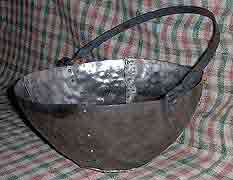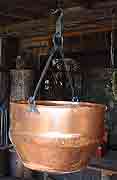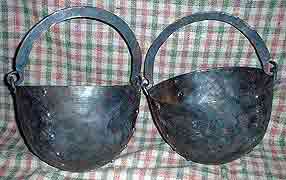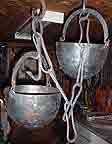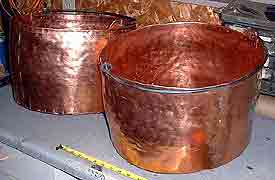As you have seen stated several times, the Wareham Forge specializes in 'Historic Reproductions in Metals'. The objects shown here mark a number of differing time periods, and include both forge work and sheet forming techniques. Past work can be found in daily use at a number of living history museums, as well in the hands of re-enactors of a range of historic periods.

This is the maker's mark I have been using since the early 1970's (longer than I have been working with metals!). It is a simple graphic, easily made with the straight cutting and round hole punching chisels found in the smith's tool box since ancient times. The design is based on a traditional Japanese crest called 'the stars and swords'. It provides for an easy reference for reproductions introduced for use in living history museums, where detailed copies are almost impossible to tell from original artifacts!
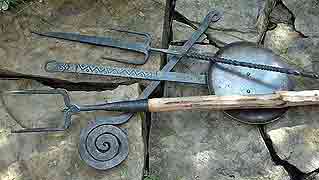 |
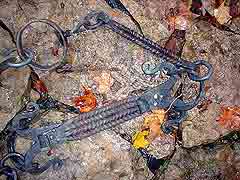 |
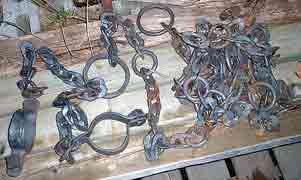 |
In Fall of 2006 I was contacted by Ian Greg - a well known Halifax area set
designer. 'Outlander' is a feature film that was shot in Nova
Scotia. The story is set in Sweden circa the early Viking Age. ( The plot of
Outlander is best described as 'Beowulf meets Alien'.) Ian was in the process
of building a small Norse village with about a dozen structures. Along with
the chieftains hall and various other dwellings, there will be a blacksmith's
shop.
I had been asked to provide a wide range of historically accurate Viking Age
cookware and tools. All the pieces were created to 'replica' standards - the
forms are based in most cases on known artifacts. For a further commentary on
the historic prototypes and the work that was undertaken on the project, I have
added a detailed section - HERE
Outlander - 2006 The large copper cauldron see here holds about five gallons. It is made of copper sheet, and uses an upper cylinder, a lower conic section and at bottom a shallow bowl. the pieces were first secured with rivets, then soldered to water tight. I also was asked to supply a number of segmented 'iron' pots. The large pot on the right is make up of eight pieces (seven segments plus dished base). The size is roughly three gallons. |
||
Disney - 2005 I was contacted by Disney in winter of 2005 to help equip a new historic based presentation for the Norway pavilion at Epcot in Florida. I provided a reproduction axe and spear, a helmet, plus some cooking gear. The two smaller pots are made from one piece spun bowls. These have been worked hot over a ball stake to alter the machine made surface. Then several lines of rivets were applied to suggest segmented construction. The second image shows them with the simple chain hanger also created for the display. |
||
French River- 2004 - 2005 Over fall 2004 through spring 2005 I worked on a wide range of pieces for a new interpretive centre being built to highlight the history of the French River in Ontario. Specifically I produced objects from the French Fur Trade era, from supplying historically accurate glass beads, replicas of a number of specific axes, and a large number of pots and related cookware. These two large copper pots were based on those traded by the Hudson's Bay Company in the early 1800's. Each is formed of hammered copper, with the individual pieces 'stitched' together and soldered. (This same technique is seen on the Viking Age Mastermyr cook pot.) |
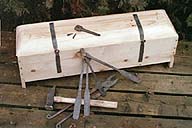
|

|
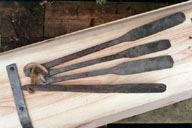 |
| |
|
|
In Spring and Summer of 2001 I was involved in another major museum project related to the Viking Age. As part of my ongoing work with L'Anse aux Meadows NHSC, I was part of a team involved in the production of a new reconstruction for the site - based on the iron smelter originally located on the site. Archaeologist Dr. Birgitta Wallace and historic metallurgist Arne Espelund provided the historic and technical aspects, I was the 'practical' consultant. The objects shown were produced for the physical presentation at the site.
A new replica of the Mastermyr Tool Box (original from Gotland, Sweden circa 1150 AD), was created. It is made of pine with forged hinges. The box originally included with the 1997 Encampment was really beginning to show its age!
An additional set of blacksmith's tools was supplied, again largely based on those from Mastermyr. The original set of tools was centred around possible rivet or nail production. With an eye to the requirements of working a possible iron bloom, the hammer and tongs were increased in size. The new hammer weight was about 1.5 kg (the original hammer was the more useful 800 gm.)
To illustrate the end result of the smelting process, a number of currency bars were included. These were actually forged from antique wrought iron, thus duplicating both form and material or the artifact prototypes. While they were being forged, the reason for the distinctive Norse 'paddle' shape became clear. The smelted billets would be drawn out to roughly 1 cm square bars - a useful starting size for the blacksmith. The flattening of one end to a thin paddle quickly shows the quality of the wrought iron - if there is too much slag content the metal will split. The reason for the punched hole at the top was for ease of transport - a number of bars can be threaded on a rope or thong for carrying.
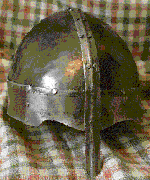 |
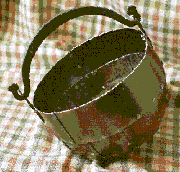 |
| |
|
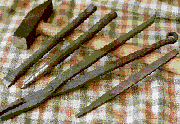 |
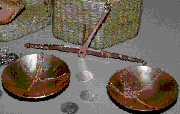 |
| |
|
All the pieces above were created for the Denver Museum of Science and Nature, to accompany their presentation of 'Vikings - North Atlantic Saga' in spring of 2001. Although I had already done a number of pieces for the 'educational kit' which was traveling as part of the collection, the Denver Museum was launching an ambitious addition to the main exhibit. They designed and produced a second 'Viking Village' - over 2000 square feet of associated, largely hands on, display. I worked on a number of aspects of the presentation. For the items used in the Viking Village, the artifact prototypes were those seen in the main exhibit whenever possible. A number of these pieces traveled to the Science Museum of Minnesota in St Paul, who created a similar presentation for their display of Vikings NAS.
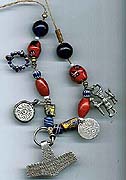 |
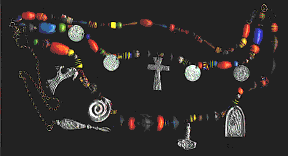 |
| |
|
Here are two pieces based on Viking Age pendant necklaces with glass beads. Care was taken in both cases to use a range of types similar to those from the period. This presented a bit of a challenge, as much modern bead work uses plastic! The beads seen are mainly from India, hand made using the same techniques as would have been used in the Viking Age. A notable exception are the tubular 'millifiori' beads - which are actually antiques from the late 1700's North American fur trade.
The first necklace is based on a silver Thor's Hammer from Rømersdal, Denmark, circa 1000 AD. The piece is in my personal collection, and was created in 1993 for the original 'Norse Encampment'. One major difference from the artifact is that the original was cast, this replica is cut from sheet. The pendant includes a stamped silver coin, based on those found at the Coppergate site in York England. The other pendant, of cast tin alloy, is an original design, again based on an artifact from Coppergate.
The second set of glass beads with associated cast pewter mounts was created for a serious Viking Age re-enactor. She chose the individual mounts from the 'Medieval Pewter Castings' I offer, then left it to me to add the glass beads. One requirement for the design was that the three individual sections would be slightly differing lengths to allow them to hang between a pair of 'turtle broaches' that she already had. One inaccuracy was the use of modern spring catches on the end of each strand. This allows the pieces to be linked into one long strand necklace. The placement of both beads and mounts had to be considered to allow for comfortable wear in this method.
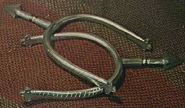 |
| |
This pair of Norman spurs (3/98) is one set of two different pairs of reproductions commissioned by John Krivjansky. He is a member of 'Milites Normannorum' - a group of very serious re-enactors of the early Norman period. In this case I worked from photographs of the original artifacts, plus a 'size as' mock up that fitted John's boots. This is a nice example of how reproduction work is not only an exercise in creating shapes, but can also be an experiment in duplicating period forming steps as well.
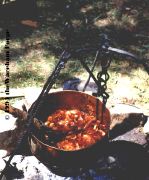 |
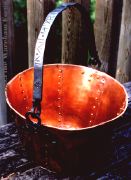 |
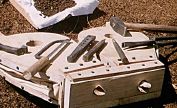 |
| |
|
|
Here are a series of objects reproducing artifacts from the Viking Age - an area I have concentrated on for the last ten years. The first is a grouping of fire irons, including a reproduction of the tripod from the Oseberg ship burial (8/91), a large copper cauldron with its hanger (7/94) plus a number of smaller cooking tools (6/93). This set of cooking equipment was made as part of the over 200 objects used as part of the original Norse Encampment presentation. They are part of the personal collection of Vandy Simpson and myself.
The second piece is a copper pot (7/91), based on one of the other styles used in the Viking Age. It was commissioned by Susan Bridges, along with an Oseberg style tripod and other cooking tools.
The last grouping is the collection of blacksmith's tools created for the Viking Encampment presentation at L' Anse aux Meadows Newfoundland. The hand tools are all reproductions of those found at Mastermyr, Norway circa 1150. The bellows itself is based on a wood carving found on the Urnes stave church from Norway. Considerably more information on reproductions from the Viking Age can be found by going to the 'Norse Encampment' series (link below).
 |
 |
| |
|
These two pieces are examples of work from the Settlement period of Canadian history. The brass ladle (1990) can be found at Black Creek Village in Toronto in the 'First House'. It was made to allow the original to be put on display, away from the strain of constant use. The metal had become paper thin and covered with stress cracks from over 100 years of polishing. The reproduction is shown along side the original (the shiny one). The second piece is a 'Courting Candle' (1990), again based on an artifact from the Black Creek collection. This version has the metal frame mounted on a burl wood base, and is in my personal collection.
